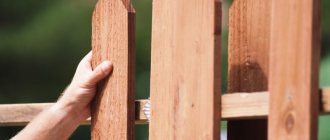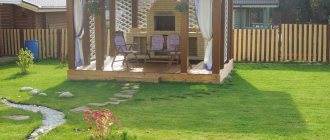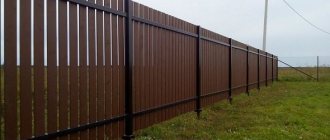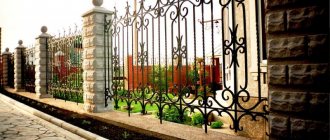The use of screw piles for the construction of fences and fences has become increasingly popular in recent years. This is due to a number of advantages of this technology. Piles are suitable for most soils (including granular soils and permafrost), they can be installed independently and very quickly, the cost of work is relatively low. At the same time, pile-screw structures are distinguished by reliability, stability and durability. True, they cannot always be used, and in some situations certain precautions will be required.
Basic elements of a fence design
A fence is a protective enclosing structure that can be made of different materials:
- wood;
- concrete;
- brick;
- block elements, etc.
There are many options, but they all form a fencing fabric consisting of the same elements:
- supporting elements (pillars) holding the canvas in a vertical position;
- technological openings, gates, wickets;
- the canvas itself, which limits access (often visibility) to the territory for unauthorized persons.
Often the support system is made in the form of a continuous foundation strip running in the lower part along the entire length of the fence. There are also canvases supported only by pillars without support from below (possibly supported on the ground). In any case, the stability of the fence and its ability to accept operational loads depends on the strength and reliability of the pillars (supports).
Construction Features
This type of fencing is different from others. The screw piles that are used in its construction have their own distinctive characteristics. By comparing them with other building materials, you can make sure that their price is optimal.
Diagram of a fence on screw piles
What are screw piles for a fence?
These are metal pipes with a blunt and pointed end, on which there are screw blades. The material for their production is durable, seamless, seamless steel pipes. The use of this technology makes it possible to make the housing more resistant to corrosion processes. The service life of a pile with a welded tip is influenced by the quality of the seam. Reviews will help you choose the right products.
The thickness of the pipe varies from 4 to 7 mm. Piles may vary in length. The shortest are 1 m. The design of the tip facilitates installation. The product has excellent resistance to pull-out or compression.
What are the disadvantages of screw piles for fences?
- When installing steel products in hard ground, there is a high risk of damaging the anti-corrosion coating. If this happens, then in the future the steel body will begin to collapse, and the load-bearing capacity of the pile will greatly decrease.
- If a pile field is located near tracks where electric trains run, or the location of electrical substations, then the load-bearing capacity of the piles is also reduced, since stray currents accumulate in the soil, causing degradation of the metal.
Types of piles
There are four types:
- With welded tip;
- With molded tip;
- Two-blade;
- Having increased load-bearing capacity.
The last variety is considered the most reliable. Piles are used not only for the construction of spiral fences, but also for low-rise buildings, gates, power line supports, bridges, greenhouses, and industrial facilities.
Why is it profitable to build fences on screw piles?
The undeniable advantages of screw piles:
- The products are perfect for different soils. The fencing structure will last for many years, regardless of whether it is located on loam or peat bogs. Will not affect the strength and high level of groundwater.
Reviews from builders indicate that the piles have proven themselves to be excellent in swampy areas. Their use makes it possible to build on slopes or terrain with significant differences in height.
- Construction work can begin at any time of the year. These piles are installed in all weather conditions. If you need a fencing structure in a permafrost zone, this is an excellent option.
- Easy to install. The fence is easy to install: metal pipes are screwed into the ground like screws, so there is no need to use special equipment. Since screw piles do not require concreting of supports, the cost of such a fence is more than affordable. Reviews from summer residents about the foundation for piles only confirm that its price is lower than that of other foundation options. In economic terms, as well as in practical terms, this design is beneficial, since there is no need to carry out preparatory work.
If we compare the cost of a pile-screw foundation with a strip or column type, it is 40–50% lower.
- Installation speed. One pile can be screwed in in approximately 20 or 30 minutes. It will take 2-3 days to erect pillars on a screw base.
- Long-term operation. If you read reviews from owners of summer cottages, the fence lasts for 50 years.
When screw piles are treated with a special agent before installation, which helps to effectively protect the metal from corrosion, then the products can be used for more than 100 years.
- Installation in rocky soil is difficult to perform without damaging the protective coating of the metal pipe.
- Additionally, anti-corrosion treatment is required, without which the risk of rotting of the product increases.
- It is impossible to check whether a twisted pile has hidden damage.
- Managers selling products, due to their inexperience or ignorance, may recommend purchasing a smaller number of piles, which is necessary to construct a high-quality foundation for a future building.
What loads are the most dangerous?
The fence fabric experiences different types of loads:
- mechanical. This includes impacts of various types - from direct attempts to destroy the fence, to accidental emergencies (for example, hitting a truck while turning, etc.);
- wind;
- operational (impacts from gate leaves or hanging objects - lamps, alarms, protective systems);
- ground (flooding, frost heaving, subsidence).
The greatest danger is posed by wind loads. A strong gust affecting a large area of canvas can overturn the fence. Sometimes it is moved from its place or torn from its supports and carried away a considerable distance.
In regions with possible hurricane winds, it is necessary to install reinforced supports and make canvases permeable to air flow. This helps reduce the load on the canvas.
In addition, soil influences are often the cause of problems. If frost heaving of the soil is observed on the site, it is necessary to make independent (or deeply buried) supports, and it is also recommended to abandon the solid foundation strip - it will begin to be squeezed out of the ground, the laying level and configuration of the supports will change.
Burying process
It is recommended to begin installation with a trial deepening of the support. This is done in order to determine the quality of the soil in a practical way, since sometimes theoretical information is not enough. The same applies to determining the level of dense soil layers.
Installation of piles is carried out mechanically and manually and does not require digging holes or waiting for concreting. To install 1 support you need 11-15 minutes.
Another feature that you need to know about even before starting to deepen screw piles is the need to immerse the supports below the freezing level of the soil. This measure allows you to reduce the load exerted by heaving forces on the piles, as well as more securely fix each of the pillars.
Before starting work, the area is marked in the same way as when installing any other type of fence.
It is convenient to use piles; they do not disturb the landscape, since they pass through soil layers “pointwise”
The process of deepening pillars with this design is implemented by two methods:
- Manually, using a lever with a long arm, which is inserted into the technological hole provided for this purpose on the upper section of the pile;
- Using special equipment, which will somewhat simplify the task of installing poles, but will require additional costs.
The first option is more accessible. Having chosen it, it is recommended to involve 1-2 assistants, since the process of deepening the supports involves applying unidirectional forces at each end of the lever, as well as simultaneously checking the insertion of the pile, since it is necessary to ensure that the pillars are perpendicular to the surface.
Tips at work
To simplify the task of deepening the screw supports, you need to prepare shallow holes at the points of future installation of the pillars before starting installation. This will make it easier for the supports to enter the ground. The sufficient depth of such holes is up to 20 cm.
Another feature of arranging a fence of this type is the need for partial concreting of the hole in the area closer to the ground surface. But such a solution is advisable to implement only in the case where a fairly heavy fence is being erected. And in order to strengthen it, concreting is carried out.
If a screw support of limited height was used, a post is attached to it using a threaded connection for fastening the fence sections. This definition includes loams, sandstones, peat bogs, marshy soil, as well as the option with watery layers located close to the surface. But this is only if you work with assistants, since screwing in the piles requires effort on both sides of the lever.
What are screw piles
Screw piles are a special type of pile foundation that can provide reliable support and have soft, gentle installation techniques. Unlike conventional types of piles, which require the use of special pile driving machines (drivers) or the production of wells for bored shafts, screw structures are driven into the ground using special methods.
Screw piles are screwed into the ground like large screws. This is facilitated by their design, which consists of four main elements:
shank with mounting holes for connection to special equipment or capstan;- a pile shaft made of seamless steel pipe (pipes of different diameters are used);
- tip (it can be pointed or be a kind of jagged cutting tool like a roller cone);
- blades, which are like a spiral thread of a screw. They can have different sizes, be located immediately behind the tip or placed along the entire length of the barrel in separate groups.
After being immersed in the ground, the screw pile rests either on solid layers or on its own blades and side walls of the trunk (using friction force). The depth of immersion of the pile depends on the properties of the soil in the area, upcoming loads, the height of the structure being held and other factors.
The main feature of screw piles is that they are undemanding to the condition of the site. Their specificity is such that no surface preparation is required; they can be built on slopes, in folds of the relief. All you need is to mark the site in accordance with the drawing of the pile field.
When all the piles are loaded, they are cut in height so that all the tops form an even horizontal plane. After this, the heads are put on them, welded, and the harness is assembled to give the entire system structural rigidity.
Maksim
Builder
For the construction of linear structures (in our case, fences), a specific shape of the pile field is selected. It represents one straight line (or not one, but a polygon of several straight lines). There is no need to assemble the piping (grillage), which greatly facilitates and speeds up the work.
— Maxim the Builder
Installing a fence on screw piles with your own hands
An important advantage of screw piles is that, unlike driven piles, they can be installed manually. This will require at least one, and preferably two, assistants.
In the head of the pile there is a through hole for installing crowbar, which is extended with pieces of pipe, so that on each side you get a lever 2-2.5 m long.
An inexpensive option for mechanization is screwing using an electric drill and a special gearbox. The latter reduces the number of revolutions, while increasing the torque in the same proportion. The gearbox can be rented.
To install a large number of piles, it is recommended to use a special machine. You won't be able to rent it - a qualified operator is required.
It is inconvenient to install the gearbox at a high height, so you should be prepared for the fact that the pile will first have to be deepened somewhat manually.
Varieties
There are many types of screw piles. They differ in several ways:
- trunk diameter;
- barrel length;
- tip type;
- configuration and number of blades.
The main factor determining the quality and degree of operability of the pile is the type of tip.
There are several types:
- welded tip . Its mechanical capabilities are much lower than those of die-cast models. As a rule, piles with welded tips are used on homogeneous soft soils without rock inclusions.
- cast tip . It is distinguished by its strength, resistance to loads, and the ability to split obstacles encountered (if they are not represented by durable igneous rocks).
To build a fence, it is not necessary to choose piles with a cast tip, since they are expensive and often have redundant qualities. However, if the soil is rocky and replete with solid inclusions, it is better to use them. Welded tips perform poorly in such conditions and often fail when encountering obstacles.
In addition, the quality of the piles is determined by the type of blades. Soft and loose soils require trunks with wide blades. They are able to form supporting surfaces that prevent subsidence. If the soil is dense and hard, use piles with small blades that resemble the cutting of a screw.
The following types of piles can be used to build a fence:
- multi-turn . The diameter of the blades is small, but the cutting configuration provides high stability when submerged. Piles of this type are used on hard and heterogeneous soils;
- bilobed . They perform well on loose and unstable soils. A pair of blades ensures uniform distribution of the load and contributes to greater stability of the trunk in the ground;
- with open tip . It has a cut in the shape of the tip of an injection needle. Used on different types of soil to create support for the construction of light structures;
- with closed tip . This is the most popular type of piles used for any soil and structures.
- single-blade . A universal option, suitable for most types of soil (except rocky and some hard types). Used as support for light structures.
To correctly select piles, you need to know the composition of the soil, the presence of solid inclusions in it, the depth of aquifers and other geological features of the site. Purchasing piles at random usually results in too many failed shafts.
Pros and cons of a pile-screw foundation
Pile foundations are fundamentally different from strip and slab foundations in that each pile transfers a concentrated load to the ground at a separate point. A pile-screw foundation, in turn, differs from a pile-driven foundation made of reinforced concrete piles in that:
- Piles are metal pipes that resist bending much worse than reinforced concrete.
- Metal piles in the ground are susceptible to corrosion.
- Driving screw piles, unlike driving driven ones, does not compact, but loosens the soil.
Due to these factors, the quality of a pile-screw foundation very much depends on the properties of the underlying soil. The ideal “cushion” for a screw foundation is thick dry loam or slightly moistened alluvium, sand with inclusions of small pebbles. In the latter case, the pile screw, when screwed in, pushes an increasingly expanding and compacting cone of soil in front of it. At the same time, water is squeezed out of it, and small particles of clay, always present in alluvium, cement it. Eventually, the soil cone acquires the strength of concrete, and the cones of individual piles close together in depth. The pile is jammed tightly, so that it is easier to twist it into a corkscrew than to twist it in or out further; the strongest foundation is now ready virtually without a zero cycle.
Gazebo with bath on screw stilts
In fertile multilayer soils in most of the Russian Federation, the foundation pile works differently. We’ll look at how below, but for now we’ll indicate the pros and cons of screw piles in Russia, with the exception of mountainous regions and permafrost zones:
- There is no need to plan the site and equip access roads to it - a plus.
- Construction is not tied to the season, weather/natural conditions and geographical location of the facility; the piles can be wrapped both in a swamp and in permafrost - a plus.
- The labor costs for installing a pile-screw foundation are an order of magnitude or less less than any other; it can be assembled in 1-3 work shifts - a plus.
- There is no need to wait for the foundation to shrink; construction can begin immediately after its installation - a plus.
- Extensions to the main building can be made without fear of shrinkage of their foundations relative to the old one - a plus.
- Construction is possible in an area of developed underground communications - a plus.
- Using industrial assembly methods and in combination with a reinforced concrete strip pile-screw foundation allows construction on the weakest soils, even quicksand - a plus.
- The same industrial construction technologies make it possible to remove piles from the ground for reuse - a plus.
- Limited service life: in moist soils with a chemical reaction other than neutral, metal piles last 50-60 years; drilling (see below) up to 100-120 years – minus.
- Load-bearing capacity limited by soil properties: capital multi-storey construction on pile-screw foundations is impossible - minus.
- Pile-screw foundations for long-term residential buildings are 10-30% more expensive per unit of load-bearing from the building than pile-driven or strip foundations - minus.
- Construction of a basement is impossible, because... the interaction of the piles with the soil is disrupted - minus.
- The penetration of flowing water into the subfloor of the building is unacceptable, so a rather complex finishing of the basement and blind area is required - a minus.
- Installation of the foundation requires preliminary geological research at the construction site and quite complex and time-consuming calculations. If it is possible to develop standard designs for strip foundations, then each pile-screw foundation is designed individually - a minus.
In individual construction, the advantages of a pile-screw foundation certainly outweigh its disadvantages in the following cases:
- Temporary light residential buildings. Let’s say we take out an inexpensive affordable mortgage for a prefabricated panel house, and next to it we gradually build a permanent mansion ourselves.
- Wooden baths: reliable insulation of the floor from the ground gives fairly light and soft steam from a metal stove.
- Outbuildings, sheds, trellises.
- Fences.
- Swing gates.
Sliding gate posts should not be made from screw piles: the mechanism still requires thorough concreting, and its shrinkage will subsequently lead to warping of the sash; Also, the piles do not hold up well to regular alternating loads when they are extended/retracted. Pile-screw foundations are not very suitable for garages either; for entry and exit you will have to make a ramp about 0.5 m high, which is inconvenient, takes up space on the site, complicates and increases the cost of work
The exception is welded metal garages, but everyone knows their aesthetics.
Advantages and disadvantages of screw piles
The advantages of screw piles include:
- ease of installation;
- the ability to drive piles in close proximity to the walls of the buildings being used;
- the ability to drive piles manually, by 4 people (provided the soil is sufficiently soft);
- piles can be reused - they can be removed and reinstalled in another place;
- There is a large selection of models on sale, suitable for any soil conditions;
- The working qualities of screw piles allow you to create fully functional support systems for any structures.
Flaws:
- the installation of each shaft is carried out at random, and any failure becomes the reason for the recalculation of the pile field;
- despite the protective coating (a layer of galvanization and protective paint), screw piles are susceptible to corrosion due to stray currents and difficult operating conditions;
- There are a large number of low-quality products from unknown manufacturers on the market.
Despite some disadvantages, the demand for screw piles is stable and constantly increasing. Low cost and ease of installation, reliability and high load-bearing capacity outweigh the disadvantages and become decisive arguments in favor of this type of support.
Reviews
Those who have had the opportunity to build a fence on screw piles are unanimous in their opinion: this is an excellent solution.
The following advantages are attracted:
- light weight. To deliver screw piles, you only need a passenger car with a trailer. In contrast, to deliver concrete piles with the same diameter, a transport with a lifting capacity of several tons equipped with a crane is required;
- ease of installation. As was shown, when screwing in a screw pile, you can do without any means of mechanization at all - you just need to have a crowbar and two pieces of pipe of sufficient length. A pile driver is required to drive a concrete pile, and a crane is required to install it in a vertical position.
If we compare it with manual methods - the production of bored piles or the construction of a columnar foundation, then even then the use of screw piles has significant advantages:
- low labor intensity;
- possibility of winter installation (“wet” processes associated with pouring concrete cannot be carried out in cold weather);
- high speed (in the case of concrete you have to wait 28 days for it to mature).
Wooden fence on screw piles
Many users have encountered situations where the fence had to be moved. For example, due to the purchase of a neighboring plot or moving to a new place. Screw piles are easily removed, whereas reinforced concrete piles or foundations would have to be left behind.
The only thing in which a screw pile is inferior to a concrete one is its load-bearing capacity, but it is quite sufficient for a fence. You can also note the relatively high cost, but if you compare it with payment for special transport services or the loss of time for installing a columnar foundation, then the costs will be quite comparable.
Methods for installing screw piles
Installation of screw piles is a process of driving them into the ground using a rotational movement with some force (in the beginning, until the blades enter the ground).
The procedure is simple and is performed in a certain sequence:
- the pile field is marked;
- at the entry points of the piles, small depressions (15-20 cm) are dug for easier entry of the blades into the ground;
- screw piles are installed at the entry points and they begin to screw them in, monitoring the position of the trunk. It must be strictly vertical.
The barrel is rotated in different ways:
- using special equipment (most often, this is an ordinary tractor with special attachments);
- manually using a capstan;
- manually, using levers, in a group of several people (usually four).
Maksim
Builder
Since no destructive or impact effects are performed, piles can be installed in close proximity to the walls of residential buildings or service buildings.
— Maxim the Builder
Do-it-yourself pile installation
Before installing screw piles, it is necessary to accurately calculate the required number. To do this, the perimeter of the future fence is precisely marked on the ground, taking into account the location of gates and gates. Places for each pile are also marked. The distances between them should not exceed 2.5–3 m. Then small recesses are made for installing the piles.
To install screw piles yourself, you should provide special levers with which you will tighten them. It is advisable to use pipes with a length of 2 meters. You need at least two people to tighten the pile, making sure its installation is strictly vertical.
It is necessary to deepen the piles at least 1.5 m. If the soil is complex (permafrost, groundwater, etc.), then longer piles should be chosen and deepened by several meters. It is also worth considering the need to purchase products coated with anti-corrosion protection in such cases.
Another important point is the subsequent installation of the fence. There are two main options here. In the first case, after screwing in the piles, fairly long fragments (2-3 meters high) remain above the surface. These parts of the piles will act as supports for the fence. You can directly attach corrugated sheeting, chain-link mesh, etc. to them.
The second option is that most of the pile is buried in the ground, and a small fragment (“stump”) remains outside. In this case, it is necessary to install a pipe on top of it. It can be welded to the pile or secured with screws. The excess part of the pile can be trimmed with a grinder.
It is advisable to fill the upper part of the pile with bitumen for moisture insulation. The entire length of the hollow pipe can be filled with concrete - this will increase the stability and strength of the pile structure, and also protect it from moisture.
How to choose suitable screw piles
Selecting screw piles is not an easy task.
The criteria should be:
- trunk diameter;
- tip type;
- shape and size of the blades.
These parameters can be selected only based on reliable information about the composition of the soil on the site.
It is recommended to carry out test drilling, which will allow the geological situation in the area to be explored with maximum accuracy. If this is not possible, you can look for information from the local geological department, or at least find out about the composition of the soil from your neighbors.
- For clayey soils, piles with narrow blades are chosen. If the clay layers are thick and dense, it is recommended to choose a pointed cast tip.
- For dense rocky soils, you need a cast tip and small spiral-cut blades.
- If the soil is soft and loose (sand, sandy loam), choose piles with wide blades. The tip is welded. For a high and continuous fence (corrugated sheeting), two-blade models can be used.
Tips for choosing
When choosing a specific type of screw piles, you should proceed from a number of conditions:
1. Type of soil. 2. Type of structure, load on the pile. 3. Costs of piles (work estimates).
A similar type of pile, but with a larger diameter, can cost approximately twice as much. Therefore, for reasons of economy, it is advisable to choose the optimal pipe diameter for the construction of fences. For light fences (wood, polycarbonate, mesh) 57 mm is enough, for metal fences - 76–89 mm. In the case of heavier fences (brick, stone), you should choose 89–108 mm.
For heavy loads, it is advisable to choose piles with cast tips. When erecting fences, they usually opt for cheaper welded ones.
The type of tip design also matters - open or closed. Closed is used on loose soils such as sand and peat, open - on the rest. In the case of rocky soil, you should choose a reinforced design with double blades.
Another important point is the anti-corrosion properties of the pile. This design must be used when working on soils with high humidity, permafrost, in the presence of groundwater, etc. There are several options for anti-corrosion coatings - based on zinc and epoxy resins.
The last factor is the length of the piles. Typically, a depth of 1.5–2 m is sufficient. On difficult soils (watery, permafrost, thermokarst), this parameter should be increased to 4–5 m. Note that it is often necessary to carry out preliminary surveys before installing screw piles in problematic conditions. You can save money by buying one pile and screwing it in on the site yourself. This will help anticipate possible problems.
In addition to the depth of the depth, you should also consider the method of installing the fence on the pile foundation. The choice of the optimal pile length also depends on this, which directly affects the total cost of the work.
The procedure for constructing a fence with supports made of screw piles
The construction of a fence with supports made of screw piles takes place in several stages.
Regardless of what canvas material is used, the beginning is always the same:
- Marking is carried out along the fence installation line. Placement points for screw piles are marked. The distance between them is chosen so that the load is not too great, and the length of the spans, if possible, is a multiple of the dimensions of the material used;
- installation of screw piles. It is performed in any suitable (or available) way;
- tying the poles with upper and lower crossbars. These are horizontal beams to which the fence is attached. Beams can be made of wood or metal (angle, channel).
- Installation of fence cloth. Sheet materials or a set of piece elements are used.
This is the general scheme. Different options for filling the spans can be selected, any materials and design options can be used. However, the support systems for any option are always the same and are built using the same methodology.
Installation features
In order for the fence to serve you as long as possible, you need to pay attention to every detail. It is only in appearance that they seem unimportant - in fact, it is these little things that make up a high-quality fence.
- First, you need to make markings on the selected area. If the pillars are at different distances, the fence will not become strong.
- The guides are cooked carefully. If you place them at the bottom, in the middle and at the top, the fence will become as strong as possible.
- The distance between the guides, as well as the distance between the supports, must be the same. The bottom bar should not touch the ground, otherwise the fence will quickly collapse.
Useful How to properly pour a foundation with your own hands under a fence, calculating the depth and the need for waterproofing
Questions and answers
When using screw piles, untrained people always have a lot of questions. Some of them can be answered immediately and save users from searching for the necessary information.
Is it necessary to calculate the load-bearing capacity of screw piles when making a fence?
The thinnest piles with a trunk diameter of 57 mm can easily withstand a load of 1.5 tons. Such supports are guaranteed to withstand the weight of a fence made of piece elements. If you need a continuous fence made of corrugated sheets, you can use more powerful piles with a diameter of 89 mm. They can withstand a load of 3-4 tons. Such capabilities of piles make it possible not to make complex calculations if the weight and loads on the sheet are not too great. If you still need a calculation, the easiest way is to use an online calculator and get the required values in a couple of minutes.
How to calculate the number of screw piles?
The easiest way is to calculate the length of the building materials. It is used in the construction of fences, parapets and other lightweight structures. If crossbars made of channels 4 m long are used, you can take the span length (or distance between piles) to be 2 or 4 m. All that remains is to divide the total length of the fence by the size of one span to obtain the required value.
Which method of installing piles is better, manual or mechanical?
The mechanical method is better, since it is more reliable, and there are much fewer failures or deviations from the vertical. However, the technical approach is not possible for every area, therefore, sometimes you have to prefer the manual method. It is much more difficult and not as reliable, but in the absence of an alternative, you have to use available means.
What to do if installing thick piles is impossible, and the weight of the fence and the expected loads are too high?
In such cases, double piles are used. They are installed in 2 pieces next to each other at a distance of 3 to 8 trunk diameters. Such supports are much stronger, but they must be connected to each other to obtain double the mechanical characteristics of the supports.
How to make a fence on screw piles from brick?
A brick fence is built in the usual way. The only difference will be the start of work - marking and installation of piles is carried out. They are then connected by crossbars with a minimum height above the ground. After this, each pillar is covered with bricks, obtaining massive rectangular supports. All that remains is to lay the spans.
How to install?
Rules for installing fences on screw piles
Like any installation work, making a fence on screw piles has certain nuances.
- Before starting installation work, it is worth doing a test screwing. This is required in order to determine the required level of pile burial, which directly depends on the composition of the soil.
- Piles can be screwed in manually, as mentioned above, or mechanically, i.e. through specialized technology. It makes it possible to screw them in without additional perforation in the housing.
- Let us note the fact that with any installation methods it is worth lengthening the screw piles until they reach solid soil. This is done using couplings and only after the main pile is secured.
- After installation, the pile must be cut to the required level and filled with concrete mortar (minimum M150). This will help increase the load-bearing structural capacity and also protect against moisture.
- To protect the piles, the upper part should be primed with a special two-component composition and treated with wear-resistant, anti-corrosion mastic.
- If the area where you plan to install the fence has unusual soil, then it is enough to lay the pile to a depth of 1.5 meters, especially since it will be almost impossible to screw it deeper in such conditions.
Now let's talk about the installation features.
Drivers: advantages, disadvantages, scope of application
A driven pile foundation is a monumental structure that can withstand heavy loads. The peculiarity of the technology lies in the method of deepening the rods into the ground through the use of impact force.
As a rule, reinforced concrete pillars with a square or round cross-section are chosen as supports. The lower part of the pillar has a pointed shape so that the pile can more easily overcome the resistance of ground rocks.
Advantages of driving technology:
- increased load-bearing capacity;
- long service life of 100 years;
- strength and stability;
- ease of installation;
- high speed of construction - from one day;
- maintainability;
- reusability;
- suitable for difficult terrain and most types of soil, except rocky;
- Reinforced concrete products are not subject to corrosion.
Disadvantages of driven supports:
- the need to rent piling equipment;
- high weight of reinforced concrete products;
- difficulties in erecting piles at one level;
- impossibility of installing waterproofing for the foundation;
- the need to organize a place for the access of special equipment.
Application area:
- Construction of low-rise and high-rise residential buildings.
- Construction of industrial buildings.
- Construction of overpasses, bridges, overpasses.
- Construction of various hydraulic and engineering structures, including water intake piers, berths, etc.
Characteristic features of the foundation compared to a driven foundation
Installation of driven piles requires the services of special equipment, but screw piles can be screwed in manually. And although there is a technology for tightening with the participation of special equipment, site owners cope with this work in most cases without it. Although, it must be said that this will require considerable effort.
Installation of driven piles creates loud noise and vibration. This adversely affects residents of nearby houses and causes destructive processes in buildings. There is also a negative impact on the soil. When constructing near buildings of historical value, the installation of driven piles is contraindicated. The installation of screw supports does not have all these disadvantages. In terms of efficiency, their installation is much more profitable, and it is not only less expensive, but also much faster.
Design features
Piles have their undeniable advantages - reliability, manufacturability and durability. One can also note the ease of installation of this structure, which is not the case in such types of foundations as strip and columnar. Their installation requires a lot of labor. It is necessary to dig a hole and install formwork. This is often done in several stages.
Installing fence piles does not require large investments, the purchase of sand, gravel, cement, installation of formwork and a lot of time. In addition, fences installed in this way are considered the most reliable today.
As the name suggests, piles are hollow pipes with a thread at one end. Often, for better strengthening in the ground, instead of threads, blades are installed. But sometimes piles are made in combination: with blades and threads.
Screw piles are screwed directly into the ground due to the thread at one of their ends
Different piles are also used for different soil types:
- for sandy soils, a design with a closed tip is suitable;
- for most soils (except sandy and peaty) an open tip is used;
- for rocky rocks - thread with two blades.
It is worth noting that welded piles cannot be used to build the foundation of a house, as they do not have sufficient strength. In this case, it is better to use cast structures.
The cost of such foundation parts can vary significantly depending on the size. For example, an 89 mm pile can cost twice as much as a 57 mm one
The thicker the metal pile, the more expensive it is
It is not recommended to purchase structures with double blades for installation on ordinary soils. Their price is much higher, and their installation on “light” soils is unjustified.
Self-assembly also plays an important role. If you have the appropriate experience (possibly small), then saving money on building a fence can be up to 50% of the total construction budget.
As practice shows, a construction company needs to pay approximately the same amount for installing a support as one element costs. Additionally, you will need to pay for soil testing in your area. Serious companies will not start work without a soil analysis. If you install it yourself, you won't have to pay for it.
Tips for Beginners
In the middle zone of the country, supports must be deepened from 1.5 to 2 meters. When screwing the support into the soil, you can understand for yourself when it has found the optimal position, since the process will become more complicated and the metal will begin to deform.
If there is no relevant experience in such work, it is better to install pillars in the piles at a height of 20-30 cm. Thus, there will be no need to achieve the ideal vertical position of the support. In addition, screwing a pipe into a smaller pile is much easier than using just a long support.
To obtain the best result, it is necessary for one person to monitor the vertical position of the support, and two to screw the pile using a lever.
If halfway through the movement the support becomes harder to rotate, you don’t need to put in a lot of effort, as this will only deform the part. It is better to unscrew the support back and go through it with a smaller diameter drill. This may be due to the layer of rocky soil
It is important that the drill is much smaller in width than the pile
The length of the pile is selected depending on the height of the future fence, while half of the pile should be above the ground. For example, if a fence 1.5 meters high is being built, then it is necessary to prepare 3-meter supports.
It is important to use large diameter piles on light peat soils for the integrity of the structure. On regular ones you can also use thin supports
This is interesting: a gate in a private house.
For many people, the deciding factor when purchasing is the price of the product. The structure on supports will not only be stronger, but the cost of the product will be significantly lower than using conventional concrete pillars on a foundation.
The price will vary depending on the model, thickness and length of the part. It is also affected by the presence of additional blades for “lighter” soils.
Three workers can make a fence from screw supports, even without the necessary work experience. Thus, you can save up to half the cost of the fence. By following step-by-step instructions, you can make a very reliable design that will last for many years.











